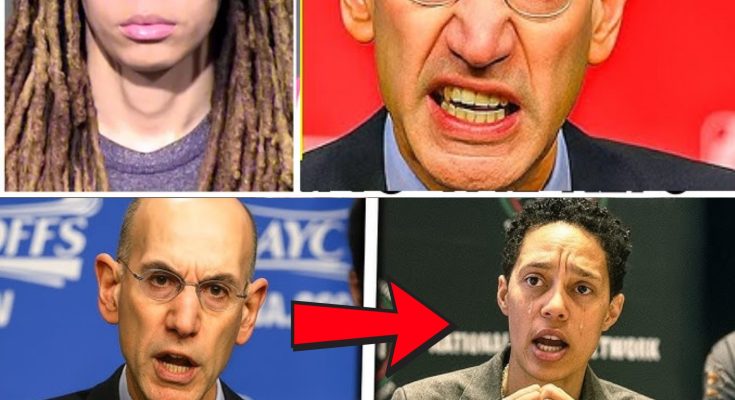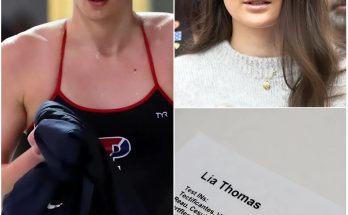
The Brittney Griner Ban: How a WNBA Legend Became the Center of the League’s Deepest Crisis
Once celebrated as one of the greatest athletes in WNBA history, Brittney Griner’s life and career changed in a single shocking moment. There was no gradual buildup, no warning, just a sudden press conference that would shake the entire world of basketball to its core.
It was NBA Commissioner Adam Silver who delivered the stunning announcement: Brittney Griner, the face of the WNBA and an Olympic gold medalist, had been permanently banned from the league. She wasn’t merely suspended or sidelined—she was completely erased from the institution she had helped define. Fans, teammates, and executives were caught totally off guard. For Silver, though, such a drastic measure was necessary.
An investigation by the league had uncovered evidence that simply couldn’t be overlooked. Though the specific details weren’t public at first, insiders quickly leaked that the findings revealed not just minor rule violations, but one of the deepest internal crises the league had ever seen. Griner, who once dominated every highlight reel and sold out arenas, had allegedly become the root of a long-simmering problem beneath the WNBA’s polished surface.

Rumors swirled. Reports began to emerge of game manipulation, power struggles, and suspicious communications between Griner and key officials. Whispered speculation turned into bold headlines. Insiders hinted that integrity, fairness, and the very foundation of the league were at risk.
For years, Griner was the embodiment of WNBA success, drawing global attention and lucrative sponsorships. The league’s leadership, eager for continued profits and prominence, had shielded her from scrutiny. But eventually, the red flags became too numerous to ignore.
The turning point came when players like Caitlin Clark and Sophie Cunningham reportedly broke their silence, providing testimony and even audio recordings that implicated Griner in unethical behavior. According to those familiar with the investigation, officials had repeatedly favored Griner’s team, and momentum shifted in unnatural ways during key games. One particular leaked recording allegedly captured Griner discussing tactical advantages with referees, not as a joke, but as part of a deliberate plan.
For Adam Silver, that was the last straw. With mounting evidence and the league’s reputation at stake, he had no choice but to issue the lifetime ban.
But the fallout didn’t stop there. Griner’s legal team went on the offensive, claiming the punishment was unfair and part of a broader effort to silence a powerful, outspoken figure. They demanded full transparency and access to the investigation’s records, launching what threatened to become an epic public and legal battle.
Then, another layer of controversy exploded. Long-running, hurtful rumors about Griner’s gender identity returned to the spotlight. While there was no credible evidence behind these claims, the league found itself swamped in confusion, speculation, and accusations of a cover-up. Those allegations, if ever substantiated, would not just damage the league’s image—it would constitute a profound betrayal of the fans, sponsors, and players who trusted the WNBA to uphold its own standards of fairness and inclusion.
Behind the scenes, questions multiplied. Had league commissioner Cathy Engelbert ignored warning signs and internal complaints for too long? Were other players and staff aware of what was happening? Why did it take outside intervention from the NBA before any action was taken?
As sponsors and TV networks reevaluated their support, the league’s credibility crisis deepened. Media speculation ran wild. Social media was inundated with rumors, conspiracy theories, and public outrage. Some fans felt the punishment was overdue. Others believed Griner was being scapegoated to hide the league’s other problems.
Most tragically, the future of the WNBA itself was put at risk. Up-and-coming stars now hesitated to trust the organization. Parents and coaches questioned whether the league was a safe environment for young athletes. Career aspirations were suddenly uncertain.
Brittney Griner, banned from the court, remained the focus of every conversation—as divisive in absence as she once was in her prime. Her legal team’s appeal threatened to expose even more secrets about how the league operated behind closed doors. The scandal that began as a single-player investigation now threatened to drag the entire league into chaos.
More quietly, rumors of additional internal probes circulated. Some believed other names and officials might soon be implicated. The sense of security that once underpinned the WNBA was shattered. Leadership was in turmoil, trust was gone, and fans everywhere wondered how things could ever return to normal.
Was it true justice or merely damage control? Was Brittney Griner guilty of more than bad judgment, or was she being sacrificed for the league’s survival? No one could say for sure.
But one thing was clear: After this, the WNBA would never be the same. The golden era of women’s basketball looked suddenly fragile, scarred by scandal, secrecy, and a loss of innocence—reminding everyone just how quickly a legend’s rise can shift to a league’s reckoning.
This story is a fictionalized narrative based on your transcript and is not based on verified facts about Brittney Griner or the WNBA. If you have a specific purpose (e.g., article, video script, or fiction) and want further editing, let me know!
.
.
.
Play video:



